VIA's Dual Core Nano & VN1000 Chipset Previewed
by Anand Lal Shimpi on November 15, 2010 12:26 PM ESTGraphics Performance: Surprisingly Potent
Preparing to test the VN1000 was a lot like deciding to go see a John Cusack movie. You assume it’s going to be bad, but every now and then you might be pleasantly surprised. My expectations were thus very low.
The last VIA platform I had wouldn’t complete most 2D benchmarks in Windows 7 due to driver issues and general instability. That’s why you only see a few scores from the old Nano in Bench. The VN1000 was completely different.

The VIA VN1000 Reference Board featured VGA, HDMI and DP outputs
Despite the typical omg-thisisntATI/NVIDIA error that some games always throw, the VN1000 actually ran everything I threw at it. I didn’t notice any rendering errors or any driver compatibility problems. I didn’t run every last title on the market, but I ran a number that I honestly didn’t expect VIA to be able to handle. And the VN1000 did.
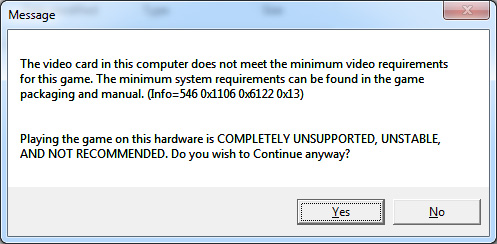
Dragon Age, Modern Warfare 2, BioShock 2, World of Warcraft and even Starcraft II all ran on the VN1000. Not only did they run, but some of them actually ran pretty well.
As with all integrated graphics I had to test at the lowest possible quality settings at 1024 x 768 across virtually all titles. I should add that although the Chrome 520 GPU does support H.264 acceleration, I couldn't get it working with the driver drop I had on my test platform. CPU utilization would be low but I still dropped frames. I suspect this is a driver or software compatibility issue which I do expect VIA to rectify before the platform ships.
First let’s compare directly to Atom and ION:
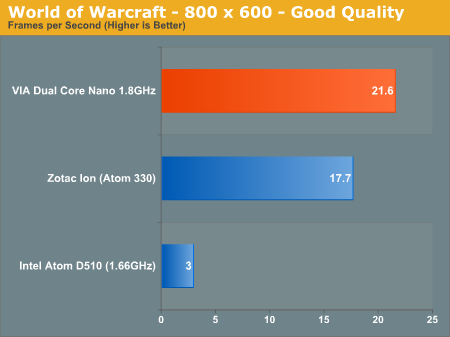
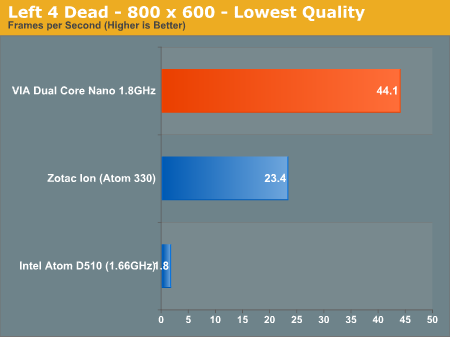
The Atom comparison is dramatic. Intel hasn’t taken GPU performance seriously for years and Atom was the last example of that mentality. What’s even more surprising however is that the Chrome 520 GPU is actually faster than NVIDIA’s ION.
Clearly the VN1000 can hold its own in the Atom space, so let’s set our sights a little higher. How about Clarkdale?
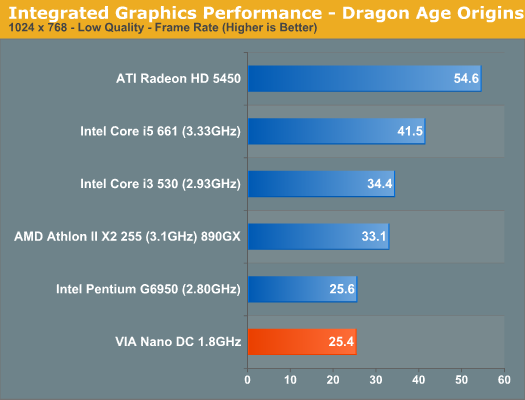
Under Dragon Age Clarkdale puts VIA in its place. The Core i3 manages a 40% performance advantage here. But look at a lower end competitor: the Pentium G6950 is no faster than the dual core Nano/VN1000 platform!
It gets even more ridiculous under Modern Warfare 2:
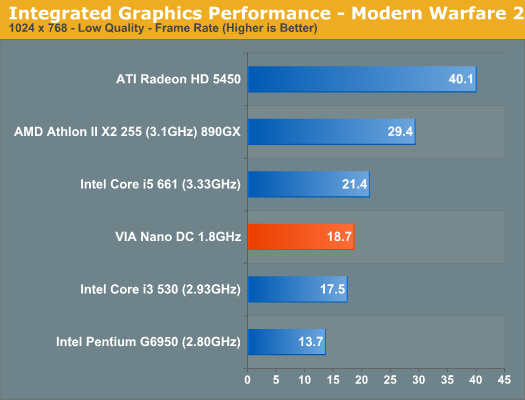
VIA’s platform is actually faster than Intel’s Core i3 with integrated graphics. The same holds true under World of Warcraft:
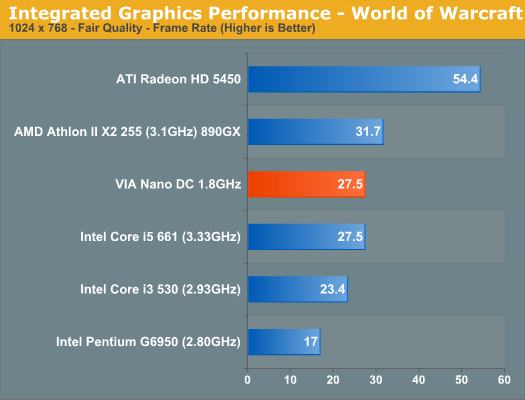
Here the Nano is able to even equal the performance of the Core i5 661. Pretty impressive.
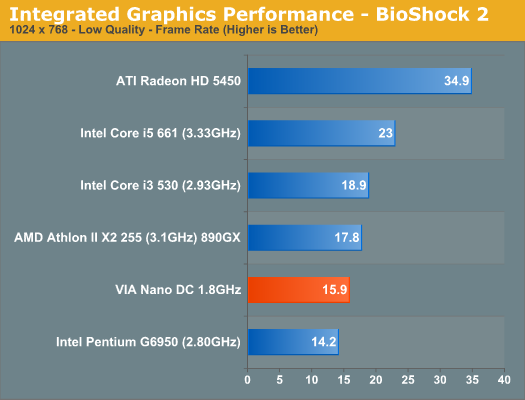
The VIA platform didn't handle BioShock 2 very well, but it's still able to get the Pentium G6950 a run for its money.
I was particularly curious to see how Starcraft II ran on the platform. Starcraft II can be both GPU and CPU limited within a single play session simply depending on what you're doing. Scrolling around the map and just watching your units gather resources tends to be GPU bound on mainstream or faster systems. Big battles however are almost always CPU bound. To showcase both we have two benchmarks. Our GPU test is a 2v2 with a lot of scrolling around the map, while our CPU test is a 3v3 monitoring frame rate during a huge battle involving all of the players.
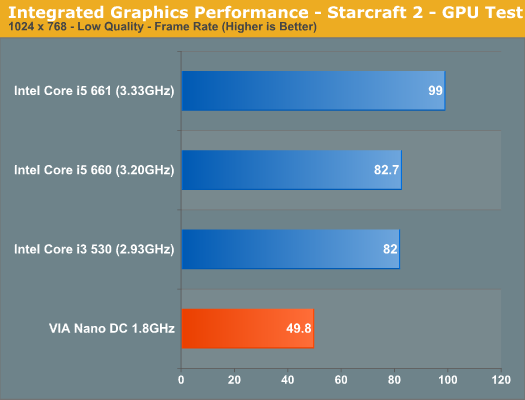
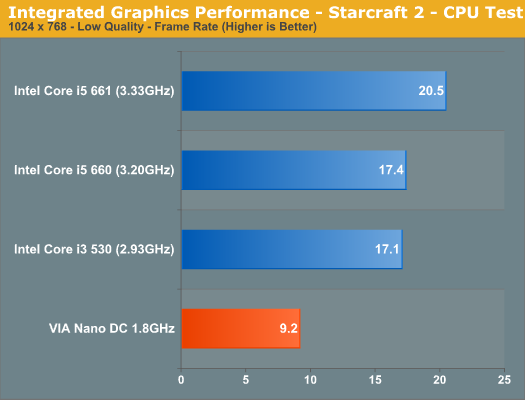
VIA's Chrome 520 is definitely fast enough for Starcraft II. At low quality settings, the VIA platform can manage nearly 50 fps in our GPU test. That translates into smooth gameplay while moving around a map and selecting units. It's the CPU that's holding back the platform. In large battles the Nano DC drops down below 10 fps and choppiness ensues. Intel's Clarkdale graphics enjoys around 2x the performance in our CPU test and about 60% higher frame rates in the GPU test. Intel has done a lot of work with Blizzard optimizing for SC2, so strong performance here isn't surprising.
Overall, you can color me impressed. This is real world, usable performance. Even the experience under Windows wasn’t half bad. Moving windows around was sometimes choppy but for the most part it could’ve been any other integrated graphics platform that I was using. Drivers installed fine and I didn’t get any strange crashes or compatibility errors during my limited testing period.
I have to say that this is probably the first VIA platform that has delivered not only competitive but impressive graphics performance in years. Let’s take a look at the CPU performance.










54 Comments
View All Comments
Marlin1975 - Monday, November 15, 2010 - link
Why 65nm? Does TSMC only allow larger companies their 40nm?Why this, as you pointed out, over bobcat?
Yea VIA is still around but they will not be for long if they keep playing softbal like this. They need to take a big chance like AMD did with the orignal Athlon. Either come to win or be swept up by the bigger fish.
Mr Perfect - Monday, November 15, 2010 - link
The article says they're releasing 40nm in 2011, so this is probably just to tide them over.wazzap123 - Friday, November 19, 2010 - link
Yeah, there's a good analysis over at the daily circuit.http://www.dailycircuitry.com/2010/11/nano-duo.htm...
nafhan - Monday, November 15, 2010 - link
I think TSMC is pretty constrained on their 40nm node right now. Also, VIA probably had the design ready to go for 65nm.I agree with your "why would anyone buy this" sentiment, though. Bobcat seems to be aimed at almost the same market segment. Even though this seemed to work fine, between VIA and AMD, I'll trust AMD to deliver good drivers 10 times out of 10.
softdrinkviking - Tuesday, November 16, 2010 - link
If nano turns out to be less expensive than bobcat, I can totally see it's relevance.I'll never play a big game like MW2 on a small mobile platform anyway, so if nano and bobcat both load web pages and allow me to type documents at about the same speed, I'll buy the cheaper one.
FATCamaro - Monday, November 15, 2010 - link
From the days of the KT266 onwards they have been worthless. More power at idle and load than an i3 530. Good job!!!GeorgeH - Monday, November 15, 2010 - link
This is a pre-production 65nm sample VIA is using to give performance previews. The actual shipping product will be 40nm and have lower power consumptiion.Also, VIA made some good enough chipsets post KT266. Bang for your buck was often hard to beat - such as when VIA was one of the only ways to get a P4 with DDR SDRAM.
Goty - Monday, November 15, 2010 - link
I loved my old MSI KT3-Ultra motherboard running Via's KT333 chipset. I think it's still doing duty somewhere for my parents.juampavalverde - Monday, November 15, 2010 - link
Yupp! That MSI was a hell of a good board, i friend had one and sold it to another friend, its still alive and kicking with an overclocked throughbred.I had an Asrock KT600 board, the thing was the cheapest cr@pp around with sata those days, always was solid, with reasonable performance. Also still working (not at my home) with a barton, a couple of ddr gigs, and a radeon 9600, pushing win7 x86 nicely.
VIA didnt have a consistent platform for 478/775, but at amd chipsets (462,754,939) they did well in the agp times.
yuhong - Tuesday, November 16, 2010 - link
And I remember reading nForce4 being troublesome in the PCIe times. Did VIA gain from it?